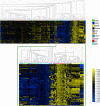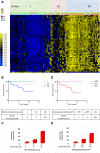DNA methylation signature is prognostic of choroid plexus tumor aggressiveness
- PMID: 31409384
- PMCID: PMC6692938
- DOI: 10.1186/s13148-019-0708-z
DNA methylation signature is prognostic of choroid plexus tumor aggressiveness
Erratum in
-
Correction to: DNA methylation signature is prognostic of choroid plexus tumor aggressiveness.Clin Epigenetics. 2019 Oct 21;11(1):144. doi: 10.1186/s13148-019-0737-7. Clin Epigenetics. 2019. PMID: 31639040 Free PMC article.
Abstract
Background: Histological grading of choroid plexus tumors (CPTs) remains the best prognostic tool to distinguish between aggressive choroid plexus carcinoma (CPC) and the more benign choroid plexus papilloma (CPP) or atypical choroid plexus papilloma (aCPP); however, these distinctions can be challenging. Standard treatment of CPC is very aggressive and often leads to severe damage to the young child's brain. Therefore, it is crucial to distinguish between CPC and less aggressive entities (CPP or aCPP) to avoid unnecessary exposure of the young patient to neurotoxic therapy. To better stratify CPTs, we utilized DNA methylation (DNAm) to identify prognostic epigenetic biomarkers for CPCs.
Methods: We obtained DNA methylation profiles of 34 CPTs using the HumanMethylation450 BeadChip from Illumina, and the data was analyzed using the Illumina Genome Studio analysis software. Validation of differentially methylated CpG sites chosen as biomarkers was performed using pyrosequencing analysis on additional 22 CPTs. Sensitivity testing of the CPC DNAm signature was performed on a replication cohort of 61 CPT tumors obtained from Neuropathology, University Hospital Münster, Germany.
Results: Generated genome-wide DNAm profiles of CPTs showed significant differences in DNAm between CPCs and the CPPs or aCPPs. The prediction of clinical outcome could be improved by combining the DNAm profile with the mutational status of TP53. CPCs with homozygous TP53 mutations clustered as a group separate from those carrying a heterozygous TP53 mutation or CPCs with wild type TP53 (TP53-wt) and showed the worst survival outcome. Specific DNAm signatures for CPCs revealed AK1, PER2, and PLSCR4 as potential biomarkers for CPC that can be used to improve molecular stratification for diagnosis and treatment.
Conclusions: We demonstrate that combining specific DNAm signature for CPCs with histological approaches better differentiate aggressive tumors from those that are not life threatening. These findings have important implications for future prognostic risk prediction in clinical disease management.
Keywords: Choroid plexus tumors; DNA methylation; HumanMethylation450 arrays; Quantitative sodium bisulfite pyrosequencing.
Conflict of interest statement
The authors declare that they have no competing interests.
Figures








Similar articles
-
Molecular characterization of choroid plexus tumors reveals novel clinically relevant subgroups.Clin Cancer Res. 2015 Jan 1;21(1):184-92. doi: 10.1158/1078-0432.CCR-14-1324. Epub 2014 Oct 21. Clin Cancer Res. 2015. PMID: 25336695
-
TP53 alterations determine clinical subgroups and survival of patients with choroid plexus tumors.J Clin Oncol. 2010 Apr 20;28(12):1995-2001. doi: 10.1200/JCO.2009.26.8169. Epub 2010 Mar 22. J Clin Oncol. 2010. PMID: 20308654
-
Pediatric atypical choroid plexus papilloma: Clinical features and diagnosis.Clin Neurol Neurosurg. 2021 Jan;200:106345. doi: 10.1016/j.clineuro.2020.106345. Epub 2020 Nov 4. Clin Neurol Neurosurg. 2021. PMID: 33203591
-
Epigenetics impacts upon prognosis and clinical management of choroid plexus tumors.J Neurooncol. 2020 May;148(1):39-45. doi: 10.1007/s11060-020-03509-5. Epub 2020 Apr 28. J Neurooncol. 2020. PMID: 32342334 Free PMC article. Review.
-
Correlation between choroid plexus carcinoma and Li-Fraumeni syndrome: implications of TP53 mutations and management strategies-a case-based narrative review.Childs Nerv Syst. 2024 Jun;40(6):1699-1705. doi: 10.1007/s00381-024-06313-y. Epub 2024 Feb 6. Childs Nerv Syst. 2024. PMID: 38316675 Review.
Cited by
-
Single-nucleus RNA-seq dissection of choroid plexus tumor cell heterogeneity.EMBO J. 2024 Dec;43(24):6766-6791. doi: 10.1038/s44318-024-00283-2. Epub 2024 Oct 31. EMBO J. 2024. PMID: 39482394 Free PMC article.
-
Choroid plexus metastasis of a renal cell carcinoma-A case report and review of the literature.Neurooncol Adv. 2025 Jul 4;7(1):vdaf146. doi: 10.1093/noajnl/vdaf146. eCollection 2025 Jan-Dec. Neurooncol Adv. 2025. PMID: 40709017 Free PMC article. No abstract available.
-
Epigenetic silencing of ZIC4 unveils a potential tumor suppressor role in pediatric choroid plexus carcinoma.Sci Rep. 2024 Sep 12;14(1):21293. doi: 10.1038/s41598-024-71188-7. Sci Rep. 2024. PMID: 39266576 Free PMC article.
-
Role of available adjuvant therapies following surgical resection of atypical choroid plexus papilloma-a systematic review and pooled analysis.Neurooncol Adv. 2020 Oct 25;2(1):vdaa139. doi: 10.1093/noajnl/vdaa139. eCollection 2020 Jan-Dec. Neurooncol Adv. 2020. PMID: 33305270 Free PMC article.
-
Clinical utility of DNA methylation profiling for choroid plexus tumors.Neurooncol Adv. 2024 Jun 12;6(1):vdae097. doi: 10.1093/noajnl/vdae097. eCollection 2024 Jan-Dec. Neurooncol Adv. 2024. PMID: 38962753 Free PMC article.
References
Publication types
MeSH terms
Substances
Supplementary concepts
Grants and funding
LinkOut - more resources
Full Text Sources
Molecular Biology Databases
Research Materials
Miscellaneous

